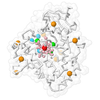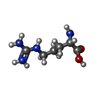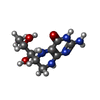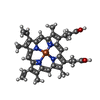+ Open data
Open data
- Basic information
Basic information
| Entry | Database: PDB / ID: 8t1k | ||||||
|---|---|---|---|---|---|---|---|
| Title | DSBU crosslinked nNOS-CaM oxygenase homodimer | ||||||
 Components Components | Nitric oxide synthase 1 | ||||||
 Keywords Keywords | CYTOSOLIC PROTEIN / Complex | ||||||
| Function / homology |  Function and homology information Function and homology informationnegative regulation of hepatic stellate cell contraction / Nitric oxide stimulates guanylate cyclase / positive regulation of adenylate cyclase-activating adrenergic receptor signaling pathway / negative regulation of iron ion transmembrane transport / response to vitamin B3 / postsynaptic specialization, intracellular component / ROS and RNS production in phagocytes / azurophil granule / synaptic signaling by nitric oxide / Ion homeostasis ...negative regulation of hepatic stellate cell contraction / Nitric oxide stimulates guanylate cyclase / positive regulation of adenylate cyclase-activating adrenergic receptor signaling pathway / negative regulation of iron ion transmembrane transport / response to vitamin B3 / postsynaptic specialization, intracellular component / ROS and RNS production in phagocytes / azurophil granule / synaptic signaling by nitric oxide / Ion homeostasis / negative regulation of vasoconstriction / response to nitric oxide / negative regulation of cytosolic calcium ion concentration / positive regulation of adenylate cyclase-activating G protein-coupled receptor signaling pathway / response to vitamin E / positive regulation of sodium ion transmembrane transport / peptidyl-cysteine S-nitrosylase activity / cadmium ion binding / positive regulation of the force of heart contraction / negative regulation of calcium ion transport / negative regulation of potassium ion transport / regulation of postsynaptic membrane potential / nitric oxide mediated signal transduction / nitric-oxide synthase (NADPH) / sodium channel regulator activity / negative regulation of serotonin uptake / regulation of neurogenesis / nitric-oxide synthase activity / multicellular organismal response to stress / xenobiotic catabolic process / L-arginine catabolic process / NADPH binding / postsynaptic density, intracellular component / striated muscle contraction / nitric oxide-cGMP-mediated signaling / behavioral response to cocaine / regulation of sodium ion transport / negative regulation of blood pressure / response to hormone / nitric oxide metabolic process / nitric oxide biosynthetic process / photoreceptor inner segment / cellular response to epinephrine stimulus / T-tubule / sarcoplasmic reticulum membrane / secretory granule / calyx of Held / sarcoplasmic reticulum / positive regulation of long-term synaptic potentiation / response to activity / cell periphery / response to nicotine / phosphoprotein binding / response to nutrient levels / establishment of protein localization / establishment of localization in cell / cellular response to mechanical stimulus / negative regulation of insulin secretion / female pregnancy / response to peptide hormone / sarcolemma / caveola / cellular response to growth factor stimulus / potassium ion transport / response to lead ion / response to estrogen / vasodilation / Z disc / calcium-dependent protein binding / calcium ion transport / FMN binding / flavin adenine dinucleotide binding / NADP binding / positive regulation of neuron apoptotic process / ATPase binding / response to heat / scaffold protein binding / response to ethanol / nuclear membrane / response to lipopolysaccharide / dendritic spine / negative regulation of neuron apoptotic process / transmembrane transporter binding / RNA polymerase II-specific DNA-binding transcription factor binding / mitochondrial outer membrane / cytoskeleton / calmodulin binding / response to hypoxia / postsynaptic density / membrane raft / negative regulation of cell population proliferation / heme binding / dendrite / synapse / negative regulation of apoptotic process / positive regulation of DNA-templated transcription / perinuclear region of cytoplasm / glutamatergic synapse / enzyme binding / positive regulation of transcription by RNA polymerase II Similarity search - Function | ||||||
| Biological species |  | ||||||
| Method | ELECTRON MICROSCOPY / single particle reconstruction / cryo EM / Resolution: 3.14 Å | ||||||
 Authors Authors | Lee, K. / Pospiech, T.H. / Southworth, D. | ||||||
| Funding support |  United States, 1items United States, 1items
| ||||||
 Citation Citation |  Journal: J Biol Chem / Year: 2024 Journal: J Biol Chem / Year: 2024Title: Mapping interactions of calmodulin and neuronal NO synthase by crosslinking and mass spectrometry. Authors: Dana Felker / Kanghyun Lee / Thomas H Pospiech / Yoshihiro Morishima / Haoming Zhang / Miranda Lau / Daniel R Southworth / Yoichi Osawa /  Abstract: Neuronal nitric oxide synthase (nNOS) is a homodimeric cytochrome P450-like enzyme that catalyzes the conversion of L-arginine to nitric oxide in the presence of NADPH and molecular oxygen. The ...Neuronal nitric oxide synthase (nNOS) is a homodimeric cytochrome P450-like enzyme that catalyzes the conversion of L-arginine to nitric oxide in the presence of NADPH and molecular oxygen. The binding of calmodulin (CaM) to a linker region between the FAD/FMN-containing reductase domain, and the heme-containing oxygenase domain is needed for electron transfer reactions, reduction of the heme, and NO synthesis. Due to the dynamic nature of the reductase domain and low resolution of available full-length structures, the exact conformation of the CaM-bound active complex during heme reduction is still unresolved. Interestingly, hydrogen-deuterium exchange and mass spectrometry studies revealed interactions of the FMN domain and CaM with the oxygenase domain for iNOS, but not nNOS. This finding prompted us to utilize covalent crosslinking and mass spectrometry to clarify interactions of CaM with nNOS. Specifically, MS-cleavable bifunctional crosslinker disuccinimidyl dibutyric urea was used to identify thirteen unique crosslinks between CaM and nNOS as well as 61 crosslinks within the nNOS. The crosslinks provided evidence for CaM interaction with the oxygenase and reductase domain residues as well as interactions of the FMN domain with the oxygenase dimer. Cryo-EM studies, which gave a high-resolution model of the oxygenase domain, along with crosslink-guided docking provided a model of nNOS that brings the FMN within 15 Å of the heme in support for a more compact conformation than previously observed. These studies also point to the utility of covalent crosslinking and mass spectrometry in capturing transient dynamic conformations that may not be captured by hydrogen-deuterium exchange and mass spectrometry experiments. | ||||||
| History |
|
- Structure visualization
Structure visualization
| Structure viewer | Molecule:  Molmil Molmil Jmol/JSmol Jmol/JSmol |
|---|
- Downloads & links
Downloads & links
- Download
Download
| PDBx/mmCIF format |  8t1k.cif.gz 8t1k.cif.gz | 199.8 KB | Display |  PDBx/mmCIF format PDBx/mmCIF format |
|---|---|---|---|---|
| PDB format |  pdb8t1k.ent.gz pdb8t1k.ent.gz | 130.9 KB | Display |  PDB format PDB format |
| PDBx/mmJSON format |  8t1k.json.gz 8t1k.json.gz | Tree view |  PDBx/mmJSON format PDBx/mmJSON format | |
| Others |  Other downloads Other downloads |
-Validation report
| Summary document |  8t1k_validation.pdf.gz 8t1k_validation.pdf.gz | 1.4 MB | Display |  wwPDB validaton report wwPDB validaton report |
|---|---|---|---|---|
| Full document |  8t1k_full_validation.pdf.gz 8t1k_full_validation.pdf.gz | 1.4 MB | Display | |
| Data in XML |  8t1k_validation.xml.gz 8t1k_validation.xml.gz | 37.3 KB | Display | |
| Data in CIF |  8t1k_validation.cif.gz 8t1k_validation.cif.gz | 52.4 KB | Display | |
| Arichive directory |  https://data.pdbj.org/pub/pdb/validation_reports/t1/8t1k https://data.pdbj.org/pub/pdb/validation_reports/t1/8t1k ftp://data.pdbj.org/pub/pdb/validation_reports/t1/8t1k ftp://data.pdbj.org/pub/pdb/validation_reports/t1/8t1k | HTTPS FTP |
-Related structure data
| Related structure data |  40970MC 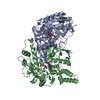 8t1jC M: map data used to model this data C: citing same article ( |
|---|---|
| Similar structure data | Similarity search - Function & homology  F&H Search F&H Search |
- Links
Links
- Assembly
Assembly
| Deposited unit | 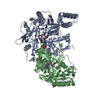
|
|---|---|
| 1 |
|
- Components
Components
| #1: Protein | Mass: 160769.562 Da / Num. of mol.: 2 Source method: isolated from a genetically manipulated source Source: (gene. exp.)   #2: Chemical | ChemComp-ZN / | #3: Chemical | #4: Chemical | #5: Chemical | Has ligand of interest | Y | |
|---|
-Experimental details
-Experiment
| Experiment | Method: ELECTRON MICROSCOPY |
|---|---|
| EM experiment | Aggregation state: PARTICLE / 3D reconstruction method: single particle reconstruction |
- Sample preparation
Sample preparation
| Component | Name: DSBU crosslinked CaM-bound nNOS homodimer / Type: COMPLEX / Entity ID: #1 / Source: RECOMBINANT |
|---|---|
| Source (natural) | Organism:  |
| Source (recombinant) | Organism:  |
| Buffer solution | pH: 7.5 |
| Specimen | Embedding applied: NO / Shadowing applied: NO / Staining applied: NO / Vitrification applied: YES |
| Vitrification | Cryogen name: ETHANE |
- Electron microscopy imaging
Electron microscopy imaging
| Microscopy | Model: TFS GLACIOS |
|---|---|
| Electron gun | Electron source:  FIELD EMISSION GUN / Accelerating voltage: 200 kV / Illumination mode: FLOOD BEAM FIELD EMISSION GUN / Accelerating voltage: 200 kV / Illumination mode: FLOOD BEAM |
| Electron lens | Mode: BRIGHT FIELD / Nominal defocus max: 2000 nm / Nominal defocus min: 1000 nm |
| Image recording | Electron dose: 62 e/Å2 / Film or detector model: GATAN K2 SUMMIT (4k x 4k) |
- Processing
Processing
| CTF correction | Type: PHASE FLIPPING AND AMPLITUDE CORRECTION |
|---|---|
| 3D reconstruction | Resolution: 3.14 Å / Resolution method: FSC 0.143 CUT-OFF / Num. of particles: 294924 / Symmetry type: POINT |
| Refinement | Highest resolution: 3.14 Å |
 Movie
Movie Controller
Controller




 PDBj
PDBj
